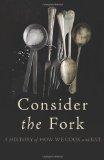We haven’t done book reviews on Three Clever Sisters before (at least, not books that don’t have recipes in them as well) but Bee Wilson‘s Consider the Fork: A History of How We Cook and Eat seems like an appropriate departure. This book, which I first read about in the New Yorker, is the latest by the British food writer and academic (and prior author of The Hive: The Story of the Honeybee and Us and Swindled: The Dark History of Food Fraud, from Poisoned Candy to Counterfeit Coffee). Lest you think that the word ‘academic’ is code word for this being dry and boring, fear not: While the book is certainly well-researched and packed with information, Bee Wilson’s engaging style and voice shines through, and you are not reading history so much as listening to an enthusiastic friend.

For me, one of the clearest takeaways is how new and novel the idea of cooking-as-recreation is, and just how much of a luxury this concept is: for those of us who like to cook, part of what makes it so is the fact that it’s not required–either because of the abundance of processed food. In fact, despite this little world of food blogs where people are making their own kimchi or mars bars, it’s no secret that home cooking is on the decline. But enjoyment in cooking is a luxury for other reasons too: as much as people thin it takes too much work to cook nowadays, the fact is that what many see as overly-onerous “from scratch” cooking is vastly less taxing (and significantly less dangerous) than historically. And the author’s perspective is more far-reaching than our collective great-grandmothers. Further back, the labors of the kitchen were as far removed as possible from the delights of the table, and with good reason–cooking was a smoky, ashy, overly hot and dangerous business: cramped, sweaty, oppressive. Today the ultimate status symbol is a spacious, modern kitchen (that may or may not have a veneer of the rustic, authentic), for however much it is actually used in fact. For the medieval European nobility, status meant kitchens that were built separated from the main house, despite the inconvenience of the daily ferrying of food to table. Kitchen fires being so common, the inconvenience of a soup that may be lukewarm by the time it completed its journey to table was preferable to having the whole castle burn down.
Being wealthy enough to construct a separate kitchen annex on your property was the most visible way of indicating wealth, but what you served was perhaps just as important. For example, serving purees was a subtle indication of just how many invisible hands you had in your kitchen: just imagine all the work that it took to press something into a smooth, silky paste with no food processors or blenders. Imagine how tired one’s arm would get beating egg whites into a stiff meringue–it takes 5-6 minutes in my powerful stand mixer alone! In contrast, in today’s world where much manual labor has been replaced by electronic gadgetry, Wilson posits that the chunky textures of “rustic peasant” style food (Alice Waters et al) is making a new kind of statement, by advertising the fact that the meal was prepared by hand (mortar and pestle!) not by machine (no inauthentic magic bullets!). Of course, I’d have to add one addendum to Bee Wilson’s observation about modern trends: the ability to make perfectly smooth purees may still subtly be communicating a status message: Vitamix blenders (and thus the green smoothie lifestyle) do not come cheap.
The book is not just an “upstairs/downstairs” exploration, however. Wilson takes on a variety of topics–how much longer it took for refrigerators to catch on in Europe versus the United States, how shipments of ice from New England could make their way to Calcutta on 19th century shipping vessels, and how the Chinese shun knife is perhaps one of the most versatile pieces of kitchen equipment.
And some of the facts are truly bizarre: like the theory explained in the New Yorker‘s review of this same book (which is what piqued my interest in the first place): how the mild, orthodontically correct overbite is a result of tableware (be it chopsticks or cutlery): cutting food into small pieces (rather than, presumably, gnawing at drumsticks the way we’d imagine Henry the VIII going about it) may very well be altering our anatomy. As the daughter of a dentist, perhaps this is a fitting place for me to wrap it up.
In short, I enjoyed this book–I love trivia like this, particularly when it’s delivered through Bee Wilson’s witty voice. But more than just a collection of fun facts, Wilson draws on her sweeping historical journey to make thoughtful observations and to raise interesting questions about what cooking, and how we eat, means today.

